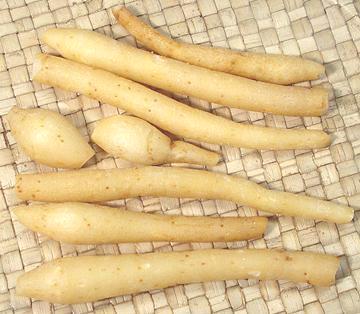 [Kra chai, Kachai, Chee-puu, Poh-see (Thai);
Fingerroot, Chinese ginger, Chinese keys, Lesser ginger (English);
Temu kunci (Indonesia); Gieng rung (Viet); Kaempferia pandurata alt.
Boesenbergia pandurata, B. rotunda]
[Kra chai, Kachai, Chee-puu, Poh-see (Thai);
Fingerroot, Chinese ginger, Chinese keys, Lesser ginger (English);
Temu kunci (Indonesia); Gieng rung (Viet); Kaempferia pandurata alt.
Boesenbergia pandurata, B. rotunda]
Originating in Southeast Asia and Southern China, this plant grows from rhizomes that have the form of a cluster of long fingers. It is not much available fresh outside Thailand, but it is available in Asian markets frozen or put up in jars of brine. Both forms are quite acceptable for use. It is availble in tiny jars as dried powder and as bags of dried strips, but dried is more bitter and less flavorful than frozen or brined. Krachai is sometimes wrongly labeled "lesser galangal", a very different plant.
Krachai is used mainly in Thailand though some is used in Vietnam, Malaysia and Indonesia. Outside those regions it is almost unknown except dried as a medicinal in China. The flavor is milder and much more earthy than ginger or galangal. It is most often used in fish dishes but also with beef and rice or as a general aromatic vegetable. The photo specimen in the front was 3-7/8 inches long and 0.52 inch diameter at the big end. These were brined.
Once a jar is opened it should be refrigerated and kept topped up with some lightly salted water or mold may set in. There is often a plastic mesh device to keep the rhizomes submerged. This way it will keep well for a few months, or the rhizomes can be drained and frozen.